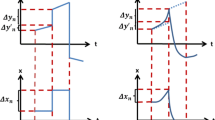Abstract
Lévy walk with multiple internal states can effectively model the motion of particles that don’t immediately move back to the directions or areas which they come from. When the Lévy walk behaves superdiffusion, it is discovered that the non-immediately-repeating property, characterized by the constructed transition matrix, has no influence on the particle’s mean square displacement (MSD) or Pearson coefficient. This is a kind of stable property of Lévy walk. However, if the Lévy walk shows the dynamical behaviors of normal diffusion, then the effect of non-immediately-repeating emerges. For the Lévy walk with some particular transition matrices, it may display nonsymmetric dynamics; in these cases, the behaviors of their variances are detailedly discussed, especially some comparisons with the ones of the continuous time random walks are made (a striking difference is the changes of the exponents of the variances). The first passage time distribution and its average of Lévy walks are simulated, the results of which turn out that the first passage time can distinguish Lévy walks with different transition matrices, while the MSD can not.









Similar content being viewed by others
References
Benjacob, E., Bergman, D.J., Matkowsky, B.J., Schuss, Z.: Lifetime of oscillatory steady states. Phys. Rev. A 26, 2805 (1982)
Bobrovsky, B.Z., Schuss, Z.: A singular perturbation method for the computation of the mean first passage time in a nonlinear filter. SIAM J. Appl. Math. 42, 174–187 (1982)
Carmeli, B., Nitzan, A.: Theory of activated rate processes: bridging between the Kramers limits. Phys. Rev. Lett. 51, 233 (1983)
Day, M.V.: Large deviations results for the exit problem with characteristic boundary. J. Math. Anal. Appl. 174, 134–153 (1990)
Deng, W.H., Wu, X.C., Wang, W.L.: Mean exit time and escape probability for the anomalous processes with the tempered power-law waiting times. EPL 117, 10009 (2017)
Duan, J.Q.: An Introduction to Stochastic Dynamics. Cambridge University Press, Cambridge (2015)
Dybiec, B., Gudowska-Nowak, E., Barkai, E., Dubkov, A.A.: Lévy flights versus Lévy walks in bounded domains. Phys. Rev. E 95, 052102 (2017)
Feller, W.: An Introduction Probability Theory and its Application, vol. 1. Wiley, New York (1968)
Gao, T., Duan, J., Li, X., Song, R.: Mean exit time and escape probability for dynamical systems driven by Lévy noises. SIAM J. Sci. Comput. 36, A887–A906 (2014)
Golding, I., Cox, E.C.: Physical nature of bacterial cytoplasm. Phys. Rev. Lett. 96, 098102 (2006)
Klafter, J., Sokolov, I.M.: First Steps in Random Walks: From Tools to Applications. Oxford University Press, Oxford (2011)
Klafter, J., Zumofen, G.: Lévy statistics in a Hamiltonian system. Phys. Rev. E 49, 4873 (1994)
Mandelbrot, B.B.: The Fractal Geometry of Nature. W.H. Freeman and Company, New York (1982)
Metzler, R., Klafter, J.: The random walk’s guide to anomalous diffusion: a fractional dynamics approach. Phys. Rep. 339, 1 (2000)
Niemann, M., Barkai, E., Kantz, H.: Renewal theory for a system with internal states. Math. Model. Nat. Phenom. 11, 191–239 (2016)
Scalas, E.: Five years of continuous-time random walks in econophysics. In: The Complex Networks of Economic Interactions, pp. 3–16. Springer, Berlin, (2006)
Shlesinger, M.F., Klafter, J., Wong, Y.M.: Random walks with infinite spatial and temporal moments. J. Stat. Phys. 27, 499–512 (1982)
Xu, P.B., Deng, W.H.: Fractional compound Poisson processes with multiple internal states. Math. Model. Nat. Phenom. 13, 10 (2018)
Zaburdaev, V., Denisov, S., Klafter, J.: Lévy walks. Rev. Mod. Phys. 87, 483 (2015)
Zaburdaev, V., Fouxon, I., Denisov, S., Barkai, E.: Superdiffusive dispersals impart the geometry of underlying random walks. Phys. Rev. Lett. 117, 270601 (2016)
Zaslavsky, G.M.: Chaos, fractional kinetics, and anomalous transport. Phys. Rep. 371, 461–580 (2002)
Zumofen, G., Klafter, J.: Scale-invariant motion in intermittent chaotic systems. Phys. Rev. E 47, 851 (1993)
Author information
Authors and Affiliations
Corresponding author
Additional information
This work was supported by the National Natural Science Foundation of China under Grant No. 11671182, and the Fundamental Research Funds for the Central Universities under Grants No. lzujbky-2018-it60, No. lzujbky-2018-ot03, and No. lzujbky-2017-ot10.
A Calculations of \(\big <x(t)\big>\), \(\big <x^2(t)\big>\) and \(Var\big (x(t)\big )\) of Subdiffusion with Multiple Internal States and \(M_6\) Transition Matrix
A Calculations of \(\big <x(t)\big>\), \(\big <x^2(t)\big>\) and \(Var\big (x(t)\big )\) of Subdiffusion with Multiple Internal States and \(M_6\) Transition Matrix
From [18], we have
where \(H(\mathbf {x},t)=\varLambda (\mathbf {x})\varPhi (t)\) and \(\varLambda (\mathbf {x})\), \(\varPhi (t)\) are matrices of jump length and waiting time, respectively. In this section, we still consider the same internal states shown in the third section. Thus if we let the jump length distribution matrix as
where \( \gamma ^{+}(l)={\left\{ \begin{array}{ll} \sqrt{\frac{2}{\pi \sigma ^2}}\exp \left( -\frac{l^2}{2\sigma ^2}\right) &{} {l\geqslant 0}\\ 0 &{} {l<0} \end{array}\right. }, \) \( \gamma ^{-}(l)={\left\{ \begin{array}{ll} 0 &{} {l\geqslant 0}\\ \sqrt{\frac{2}{\pi \sigma ^2}}\exp \left( -\frac{l^2}{2\sigma ^2}\right) &{} {l<0} \end{array}\right. }. \) And the Fourier transform of \(\varLambda (x,y)\) w.r.t. x and y is
And the matrix of distribution of waiting time asymptotically behaves as \(\varPhi (s)\sim (1-s^\gamma )I\) in the Laplace space, where \(0<\gamma <1\). By utilizing Eqs. (23) and (24) and \(\varPhi (s)\), one can get the corresponding \(\big <x(t)\big>\) and \(\big <x^2(t)\big>\) with the same method in Sect. 3. That is
and
Thus we obtain the variance
Rights and permissions
About this article
Cite this article
Xu, P., Deng, W. Lévy Walk with Multiple Internal States. J Stat Phys 173, 1598–1613 (2018). https://doi.org/10.1007/s10955-018-2152-4
Received:
Accepted:
Published:
Issue Date:
DOI: https://doi.org/10.1007/s10955-018-2152-4



